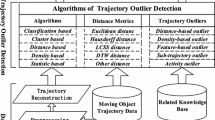Abstract
This paper presents an original method to detect anomalous human trajectories based on a new and promising context-aware distance. The input of the proposed method is a set of human trajectories from a video surveillance system. A proper representation of each trajectory is developed based on the polar coordinates of the corresponding sub-trajectories. The main focus of the paper is to highlight a context-aware distance between trajectories. This distance implies a weighted average of the differences in the angle, the Euclidean distance, and the number of points in each trajectory. The distance matrix feeds an unsupervised learning method to extract homogeneous groups (clusters) of trajectories. Finally, an outlier detection method is executed over the trajectories in each cluster. The methodology has been empirically evaluated across four experiments with both artificial and real data sets. The tests results have proved promising and illustrate the effectiveness of this approach for anomalous trajectories detection.










Similar content being viewed by others
References
San Román I, Martín de Diego I, Conde C, Cabello E (2017) Context-aware distance for anomalous human trajectories detection. In: Iberian conference on pattern recognition and image analysis. Springer, Cham, pp 140–148
Coşar S, Donatiello G, Bogorny V, Garate C, Alvares LO, Brmond F (2017) Toward abnormal trajectory and event detection in video surveillance. IEEE Trans Circuits Syst Video Technol 27(3):683–695
Zhang T, Chowdhery A, Bahl PV, Jamieson K, Banerjee S (2015) The design and implementation of a wireless video surveillance system. In: Proceedings of the 21st annual international conference on mobile computing and networking. ACM, pp 426–438
Rho S, Rahayu W, Nguyen UT (2015) Intelligent video surveillance in crowded scenes. Inf Fusion 24:12
Chan K, Fu W (1999) Efficient time series matching by wavelets. In: Proceedings of the 15th IEEE international conference on data engineering
Lin J, Keogh, E, Lonardi, S, Chiu B (2003) A symbolic representation of time series, with implications for streaming algorithms In: Proceedings of the 8th ACM SIGMOD workshop on research issues in data mining and knowledge discovery DMKD 2003, pp 2–11
Keogh E, Pazzani M (1998) An enhanced representation of time series which allows fast and accurate classification, clustering and relevance feedback. In: KDD, pp 239–243
Piciarelli C, Micheloni C, Foresti GL (2008) Trajectory-based anomalous event detection. IEEE Trans Circuits Syst Video Technol 18(11):1544–1554
Piciarelli C, Foresti GL (2006) On-line trajectory clustering for anomalous events detection. Pattern Recognit Lett 27(15):18351842
Patino L, Ferryman J, Beleznai C (2015) Abnormal behaviour detection on queue analysis from stereo cameras. In: 12th IEEE international conference on advanced video and signal based surveillance (AVSS), Aug 2015, p 16
Yi S, Li H, Wang X (2015) Understanding pedestrian behaviours from stationary crowd groups. In: Computer vision and pattern recognition (CVPR), IEEE conference on IEEE
Lim MK, Kok VJ, Loy CC, Chan CS (2014) Crowd saliency detection via global similarity structure. In: Pattern recognition (ICPR), 22nd international conference on IEEE, pp 3957–3962
Cancela B, Iglesias A, Ortega M, Penedo M (2014) Unsupervised trajectory modelling using temporal information via minimal paths. In: IEEE conference on Computer vision and pattern recognition (CVPR), pp 2553–2560
Lee J.-G, Han J, Li X (2008) Trajectory outlier detection: a partition-and-detect framework. In: Data engineering. 24th International conference on ICDE IEEE, pp 140–149
Knorr EM, Ng RT, Tucakov V (2000) Distance-based outliers: algorithms and applications. VLDB J 8(3):237–253
Siordia O, Martín de Diego I, Conde C, Cabello E (2011) Section-wise similarities for clustering and outlier detection of subjective sequential data. SIMBAD 2011. LNCS 7005, pp 61–76
Meinard M (2007) Dynamic time warping. In: Information retrieval for music and motion. Springer, pp 69–84
Kaufman L, Rousseeuw PJ (1990) Finding groups in data: an introduction to cluster. Wiley, New York
INVISUM (2014) http://www.invisum.es
Moctezuma D, Conde C, De Diego IM, Cabello E (2015) Soft-biometrics evaluation for people re-identification in uncontrolled multi-camera environments. EURASIP J Image Video Process 2015(1):28
Cancela B, Ortega M, Penedo MG, Novo J, Barreira N (2013) On the use of a minimal path approach for target trajectory analysis. Pattern Recognit 46(7):2015–2027
Cancela B, Ortega M, Penedo MG (2014) Multiple human tracking system for unpredictable trajectories. Mach Vis Appl 25(2):511–527
Veeramachaneni K, Arnaldo I, Korrapati V, Bassias C, Li K (2016) AI2: training a big data machine to defend. In: Big data security on cloud (BigDataSecurity), IEEE international conference on high performance and smart computing (HPSC), and IEEE international conference on intelligent data and security (IDS), 2016, 2nd international conference on IEEE, pp 49–54
Acknowledgements
Research supported by grants from the Spanish Ministry of Science and Innovation, under Retos-Colaboracin program: INVISUM (RTC-2014-2346-8), and from the Spanish Ministry of Economy and Competitiveness, under the Retos-Colaboración program: PPI (Ref: RTC-2015-3580-7) and UNIKO (Ref: RTC-2015-3521-7). This work has been part of the ABC4EU project and has received funding from the European Unions Seventh Framework Programme for research, technological development and demonstration under Grant Agreement No 312797.
Author information
Authors and Affiliations
Corresponding author
Additional information
A previous version of this paper appears in [1]. We have carefully revised and developed the content, most notably: we have added a mock example, tested the algorithm with the Edinburgh data set, and compared it with the trajectory-based outlier detection algorithm described in [2]. In addition, we have added a related works section.
Rights and permissions
About this article
Cite this article
San Román, I., Martín de Diego, I., Conde, C. et al. Outlier trajectory detection through a context-aware distance. Pattern Anal Applic 22, 831–839 (2019). https://doi.org/10.1007/s10044-018-0732-1
Received:
Accepted:
Published:
Issue Date:
DOI: https://doi.org/10.1007/s10044-018-0732-1




